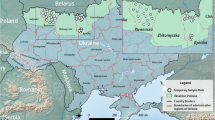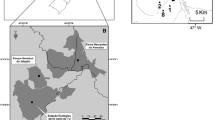Abstract
Fires are commonly used as part of the livelihood of local people in Thailand. However, population growth is causing serious problems with agricultural expansion, forest encroachment, and illegal settlement in protected areas. Human activities are causing fires in deciduous forests increasingly frequently. Understanding the fuel characteristics and fire behavior in mixed deciduous forest areas with different fire frequencies in Doi Suthep-Pui National Park will help in developing a suitable fire management plan for this area. Twenty quadrats, each 1 × 1 m, were used to collect data regarding fuel characteristics, and 50 × 50 m quadrats were used to study fire behavior in low and high fire-frequency areas. The fuel-load data were collected every month for a period of 1 year. The results indicated that in the two fire-frequency areas, the main fuel component in this forest type was litter (leaves). Fire consumed approximately 60–70% of the total fuel loads, and fuel recovery to the original level was predicted to take around 2 years. All the fire behavior features in the LFA and the HFA showed similar characteristics, and the fire type in both areas was defined as surface fire with low intensity, which usually occurs in deciduous forests of Thailand. The heat from the fire only affected the surface soil layer and did not cause any problems in deeper layers.




Similar content being viewed by others
References
Ahn YS, Ryu SR, Lim J, Lee CH, Shin JH, Choi WI, Lee B, Jeong JH, An KW, Seo JI (2014) Effects of forest fires on forest ecosystems in eastern coastal areas of korea and an overview of restoration project. Landsc Ecol Eng 10:229–237
Akaakara S (2015) forest fire management in Thailand forest fire control and forest protection office, department of national parks, wildlife and plant conservation. Thail For Prot 21:35
Andrews PL (1980) Testing the fire behavior model. In proceedings sixth conference on fire and forest meteorology. Soc Am For 3:70–77
Bargali SS, Shukla K, Singh L, Ghosh L, Lakhera ML (2015) Leaf litter decomposition and nutrient dynamics in four tree species of dry deciduous forest. Trop Ecol 56(2):191–200
Byram GM (1959) Combustion of Forest Fuels. In: Davis KP (ed) Forest fire control and use. McGraw-Hill, New York, pp 61–89
Chatto K, Tolhurst KG (2004) A review of the relationship between fireline intensity and the ecological. Research Fire management branch, Melbourne
Cochrane MA, Ryan KC (2009) Fire and Fire Ecology: Concepts and Principles. In: Cochrane MA (ed) Tropical Fire Ecology: Climate Change, Land Use, and Ecosystem Dynamics. Springer and Praxis Publishing, Chichester, UK, pp 25–62
DeBano LF, Neary DG, Ffolliott PF (1998) Fire’s Effects on Ecosystems Ecosystems. Wiley, New York
Elliott S, Maxwell JF, Beaver OP (1989) Suthep-Pui National Park. Natural History Bulletin of the Siam Society A transect survey of monsoon forest. Springer, London
Fire information for resource management system. 2019 MODIS collection 6 NRT. https://earthdata.nasa.gov/firms. Accessed 18 Nov 2019.
Forest Fire Control Division (2017) Forest fire control yearly report. Department of National Parks, Bangkok, Thailand
Goldammer JG, Wanthongchai K (2011) Fire management in South Asia’s dry forests: colonial approaches, current problems and perspectives. In: McShea WJ, Davies SJ, Bhumpakphan N (eds) The ecology and conservation of seasonally dry forests in Asia. Smithsonian institution scholarly press, Washington, D.C., pp 97–114
Graham RT, McCaffrey S, Jain TB (2004) Science basis for changing forest structure to modify wildfire behavior and severity. Rocky Mountain Research Station, London
Hafner JA, Apichatvullop Y (1990) Farming the forest: managing people and trees in reserved forest in Thailand. Geoforum 21:331–346
Junpen A, Garivait S, Bonnet S, Pongpullponsak A (2013) Fire spread prediction for deciduous forest fires in Northern Thailand. Sci Asia 39:535–545
Lertsuchatavanich C (1995) Fire index for environmental management in dry dipterocarp forest: a case study of doi suthep-pui national park. Chiang Mai University, Thailand
Murphy PG, Lugo AE (1986) Ecology of Tropical Dry Forest. Ann Rev Ecol Syst 17:67–88
Pandey U, Singh JS (1982) Leaf litter decomposition in an oak conifer forest in Himalaya: the effects of climate and chemical composition. Forestry 55:47–59
Posee N (2010) Guideline for solving forest fire problem in Doi Suthep-Pui National Park Area of Farmers in Donkeaw Sub-district, Mea Rim District. Chiang Mai University, Chiang Mai, p 129
Richard PW (1952) The tropical rain forest. Cambridge University Press, New York
Rothermel RC (1991) Predicting behavior and size of crown fires in the Northern Rocky mountains. Intermountain Research Station, Spokane, p 46
Royal forest department (2001) A synopsis of the vegetation of Thailand. Trop Nat History. 2:19–29
Rundel PW, Boonpragob K (1995) Dry forest ecosystems of Thailand. In: Bullock SH, Mooney H, Medina E (eds) Seasonally dry tropical forests. Cambridge University Press, New York, pp 93–123
Ryan KC (2002) Dynamic interactions between forest structure and fire behavior in boreal ecosystem. Silva Fennica 36(1):13–39
Saha S, Howe H (2003) Species composition and fire in a dry deciduous forest. Ecology 84(12):3118–3123
Sharp A, Nakagoshi N (2006) Rehabilitation of degraded forests in thailand: policy and practice. Landsc Ecol Eng 2:139–146
Sompoh B (1998) fuel complex in dry dipterocarp and mixed deciduous forests at huai kha khaeng wildlife sanctuary. Thesis, Kasetsart University, Changwat Uthia, p 83
Sunyaarch S (1989) Effects of fire on vegetation and soil in dry dipterocarp forest, sakaerat. Thesis Kasetsart University, Nakhonratchasima
Sutthichart K (1996) Impact of fire on soil and plant at Phu Kradung National Park. Kasetsart University, Thesis, p 88
Wanthongchai K, Goldammer JG, Bauhus J (2011) Effects of fire frequency on prescribed fire behaviour and soil temperatures in dry dipterocarp forests. Inter J Wildland Fire 20:35–45
Wanthongchai K, Tarusadamrongdet V, Chinnawong K (2013) Fuel properties and fire behaviour characteristics of prescribed fire in pine-dominated forests at nam nao National Park. Thail Inter J Wild Fire 10:23. https://doi.org/10.1071/WF11183
Wongthongchai K, Bauhus J, Goldammer JG (2014) Effects of past burning frequency on woody plant structure and composition in dry dipterocarp forest. Thai J For 33(3):109–130
Wiriya K, Kaitpraneet S (2009) Fire behavior in dry deciduous dipterocarp forest at huai kha khaeng wildlife sanctuary, Uthai Thani Province. J Nat Sci 43:41–47
Acknowledgements
This research was supported by Office of the Civil Service Commission and Department of National Parks, Wildlife and Plant Conservation, Thailand. The authors are grateful to all heads and staff under Forest Fire Control Division, Chiang Mai Forest Fire Coordinating Center, Northern Forest Fire Developing and Training Center, Chiang Dao Forest Fire Control Station, and Doi Suthep-Pui National Park.
Author information
Authors and Affiliations
Corresponding author
Rights and permissions
About this article
Cite this article
Chernkhunthod, C., Hioki, Y. Fuel characteristics and fire behavior in mixed deciduous forest areas with different fire frequencies in Doi Suthep-Pui National Park, Northern Thailand. Landscape Ecol Eng 16, 289–297 (2020). https://doi.org/10.1007/s11355-020-00419-6
Received:
Revised:
Accepted:
Published:
Issue Date:
DOI: https://doi.org/10.1007/s11355-020-00419-6




